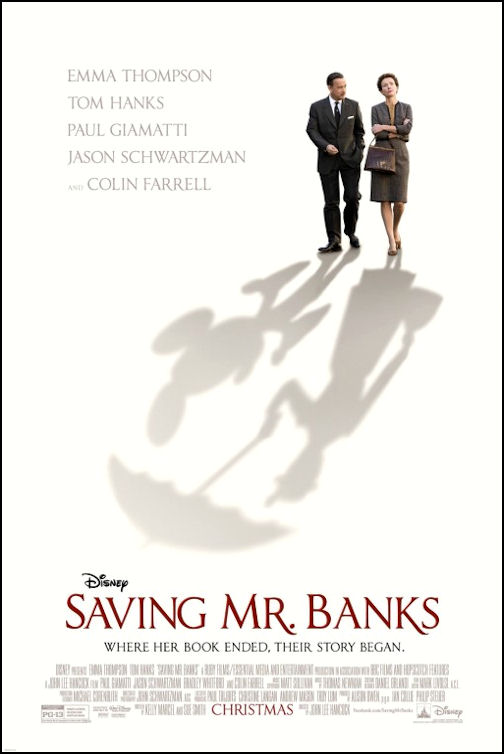Anthony's Film Review
Saving Mr. Banks (2013)

This story about the making of Mary Poppins really goes into something much deeper...
Saving Mr. Banks, a 2013 drama film from Walt Disney Pictures, was released in theaters several months before a notable milestone for the studio: the 50th anniversary of its classic 1964 musical Mary Poppins. I find this interesting, because the Disney company could've simply taken the easy approach of just re-releasing Mary Poppins into theaters five decades after its original release date, but instead (or perhaps, in addition), we have this drama film that recreates the behind-the-scenes moments during the making of Mary Poppins. That certainly got me interested after I saw the trailer. But once I finally watched Saving Mr. Banks, I was pleasantly surprised to discover what kind of movie it really is.
The way I see it, the story of how Walt Disney (played by Tom Hanks) sought to make a film adaptation of the Mary Poppins children's books written by P.L. Travers (played by Emma Thompson) is nothing more than a hook to draw us in and a platform to launch into the core story of this film: the author's emotional turmoil. Saving Mr. Banks is really a biographical film that goes back and forth between two periods in the life of P.L. Travers. One is her childhood in the Australian countryside during the early 1900s. The other is her adulthood in the 1960s when she visits the Disney studios in Los Angeles, California. Both are equally important in exploring this individual, and both are equally emotional.
As the film begins, we see Travers at her home in London, England, before she flies to Los Angeles to meet Disney and the Mary Poppins writing team at the studio. It is not long before we clearly see Travers's defining personality traits: bossy, arrogant, nitpicky, uncooperative, and condescending. She strongly believes that film adaptations of books are just horrible creations, and the one to be based on Mary Poppins would be, in her mind, no exception. This is why she insists on doing the movie her way and not sign the film rights away to Disney. The scenes that depict this are done quite well, so that we in the audience feel the same discomfort as the other characters who deal with Travers.
To contrast the unpleasantness of Travers, the film provides flashbacks of this character as a little girl. She does seem happy, even as she and her family, including her beloved father Travers Goff (played by Colin Farrell), leave behind a town life to move into a rural home. But as the flashback story proceeds, a sadness gradually creeps in, as it is discovered that the father has a drinking problem, one that slowly destroys him mentally and physically. Suddenly, the stability of the little girl's world might be slipping away.
The way this film handles flashback scenes and present-day scenes is one of its biggest strengths. Usually, a flashback scene in a movie takes you away from the present time in the story, and if it's done well, you can appreciate the present situation more. Saving Mr. Banks goes beyond this conventional approach by having the past and present feed off each other. As a result, you can better understand a present-day scene because of a flashback, appreciate a flashback because of a present-day scene, or even take in a flashback and present-day scene simultaneously so that you're experiencing one thing in two different ways.
Let me give you a great example from this movie. Consider the scene where P.L. Travers is in the Disney studio rehearsal room hearing a musical number about banks. Now throw in a flashback scene where her father, Travers Goff, delivers a passionate but ill-conceived speech about banks. The film quickly goes back and forth multiple times between the bank song and the bank speech. The words in each are the same, but the song is upbeat while the speech is shocking. After this, we see the present-day P.L. Travers moved to tears, which leads to an interesting question. Is she crying because of the speech in the past, the song in the present, or both?
This is a good time for me to discuss the other great strength of Saving Mr. Banks: Emma Thompson. This actress easily embodies the appearance and persona of P.L. Travers, making us despise the character before getting us to understand her better. Thompson will no doubt earn some nominations for acting awards. Given her memorable performance and how she has much screen time, this movie really is Emma Thompson's movie. That's not to say that Tom Hanks as Walt Disney isn't important. Even though he has notably less screen time than Emma Thompson, Hanks still delivers a good performance, and his character provides an alternative perspective that could ultimately help P.L. Travers deal with her own personal issues.
Saving Mr. Banks is an emotional film that is beautifully written and features wonderful performances by a principal cast. It also provides us with a great takeaway message: sometimes, letting go is the only way to have a chance for future happiness. Whether it's letting go of film rights or letting go of a traumatic past, holding onto something tightly might mean closing off opportunities for other good things. Overall, I'm amazed how Walt Disney Pictures has done something a bit brave and different: a new dramatic film that gives us the other side of an older Disney classic film, while still leaving us with an appreciation of both.
Anthony's Rating:










For more information about Saving Mr. Banks, visit the Internet Movie Database.
In addition, check out my review of the topically related film Mary Poppins.
Home
Film Reviews
Other Reviews
Commentaries
Links
About AFR
RSS Feed
Privacy Policy
E-mail Anthony











